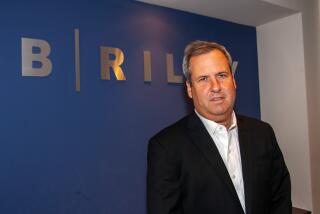HomeFed Enlists Aid of Investment Banker : Finance: Parent of San Diego-based bank hopes to shore up its capital base after $535 in losses over the past 18 months.
SAN DIEGO — The parent of troubled HomeFed Bank said Friday that it has retained an investment banker to help it explore ways of meeting capital requirements, including the possible sale of assets and branches.
HomeFed Corp., which operates the nation’s seventh-largest thrift, said it had retained Kidder, Peabody & Co. to help shore up its capital base. Buffeted by $535 million in losses over the last 18 months, HomeFed is short of two of three minimum capital requirements.
Analysts have speculated that the thrift could soon be seized by regulators. One Wall Street analyst, who asked not to be named, said Friday that the S&L; has been in a “de facto conservatorship” since Thomas Wageman was named chief executive last month.
Analysts compared HomeFed’s Friday announcement to a similar action by Great American Bank in March, 1990. Four months later, Great American announced the sale of its California branch system to Wells Fargo Bank for $491 million. However, the sale did not save Great American: regulators seized the San Diego-based thrift earlier this month.
HomeFed’s prime assets are considered its San Diego County deposit base, its 208-office statewide branch network and about 9,500 net acres of developable land and home sites in California.
HomeFed once derived a large part of its earnings from real estate development activities, but that operation is now viewed as a millstone because of higher capital requirements for development assets.
HomeFed has been trying for months to raise capital. Last March, former HomeFed chief executive Robert Adelizzi said the S&L; might spin off a portion of its S&L;’s real estate holdings to the public or to shareholders to raise cash. But Adelizzi, who was forced to resign by federal regulators in May, was unsuccessful in implementing the spinoff.
HomeFed chief financial officer Robert Nichol said Friday that Kidder, Peabody had been charged with finding a way to raise the S&L;’s deficient capital ratios while somehow keeping the S&L;’s branch system intact.
“The No. 1 objective is to get into capital compliance,” Nichol said. “The sale of the branch system is the last alternative.” He added that the S&L; feels a “sense of urgency” to improve its capital position over the next six to nine months.
Donald K. Crowley, associate director of research at Keefe, Bruyette & Woods investment firm in San Francisco, said now is a poor time for a S&L; to be trying to raise capital because so many banks and S&Ls; are in the same position. “I suspect HomeFed does not have an enormous range of options,” Crowley said.
Those options may include a sale of HomeFed real estate assets to an investor with “patience and deep pockets to realize the real estate’s value over an extended period of time,” Crowley said. A sale of the entire S&L; is possible if the “potential buyer can be shielded from HomeFed’s credit quality problems.”
Campbell Chaney, an analyst with Sutro & Co. in San Francisco, said HomeFed may have no choice but to sell branches.
“First, they will try to find capital through Kidder, Peabody, and then they will try to sell off other businesses that are not strategically crucial,” Chaney said. “Then they will resort to branch sales.”
HomeFed stock closed unchanged at $2.125 a share in New York Stock Exchange trading Friday.
More to Read
Inside the business of entertainment
The Wide Shot brings you news, analysis and insights on everything from streaming wars to production — and what it all means for the future.
You may occasionally receive promotional content from the Los Angeles Times.










